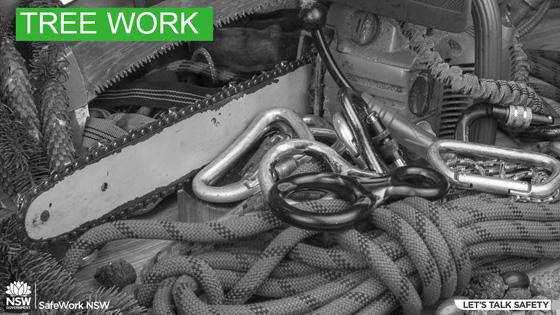Tree work (arboriculture)
Every year people are seriously injured or killed while doing tree work. Most people injured have extensive experience in tree work.
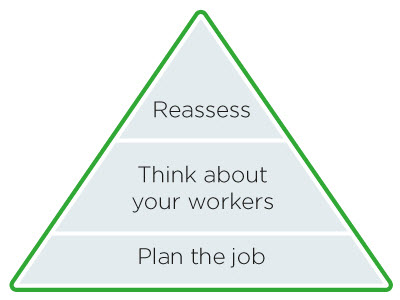
Tree work includes activities such as lopping, pruning, thinning, felling and removal of trees.
Common causes of injuries include falls from heights, being struck by falling objects, working around power lines, musculoskeletal disorders, exposure to noise, working with equipment and sun exposure.
SafeWork NSW entered into an Industry Action Plan with industry partners to improve health and safety for workers and employers and achieved many outcomes for the tree work sector.
Plan to avoid injuries in the tree work industry by following these simple tips:
Planning
- only competent persons should undertake the assessment of trees and sites, planning and preparation of the work method
- determine appropriate control measures in consultation with workers and document the safe work method to serve as evidence of managing risks
- discuss the control measures at the tool box talk
- consider conducting a site specific risk assessment
- the risks that are common to many jobs may not be re-assessed but persons undertaking the work must be familiar with the current control measures in place
- planning should consider whether the presence of plant such as an EWP will impede the cutting and lowering of tree sections
- plan emergency rescue plans, including aerial rescue procedures with everyone involved
- use of plant to access high sections can reduce fatigue and dehydration
Hazards
Hazards could be known in advance or be unforeseen. Some possible hazards are:
- condition and stability of the tree
- falling or swinging objects including tree parts that have been cut or have the potential to break
- onsite conditions that increase the risk of slips, trips and falls
- manual tasks including pulling, pushing, lifting and plant vibration
- electric shocks from energised power lines
- working with plant including mobile plant
- dehydration and fatigue
- wind and rain
- allergic reactions to trees and poisonous plants
- biting or stinging (such as insects and snakes)
Assessment of tree
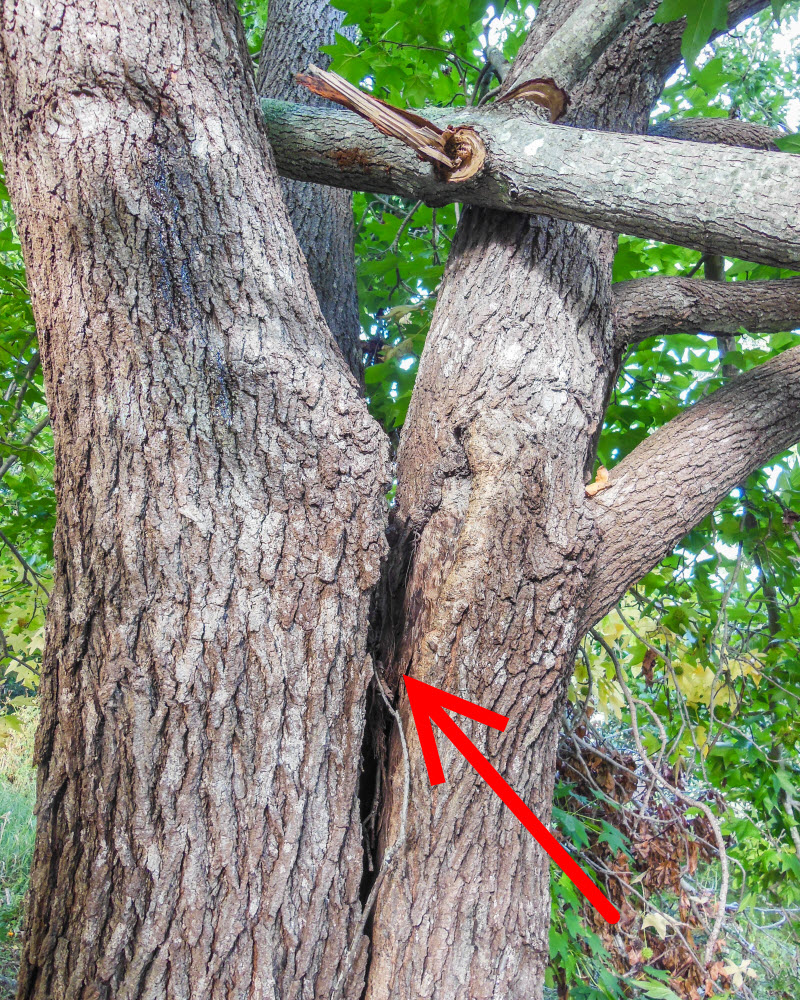
Assess the condition and stability of the tree visually. This includes noting:
- whether the tree is leaning heavily in one direction
- if there is evidence of bark inclusion
- if there are dead branches
- any signs of decay in the tree structure
- any signs of fungal fruiting bodies
- any hollows
- if there are branches intruding from nearby trees
- the presence of any concealed nests or insect colonies
- whether the tree type is susceptible to branch failure when under load
- the stability of the tree root plate by pushing or pulling the tree and observing the ground movement
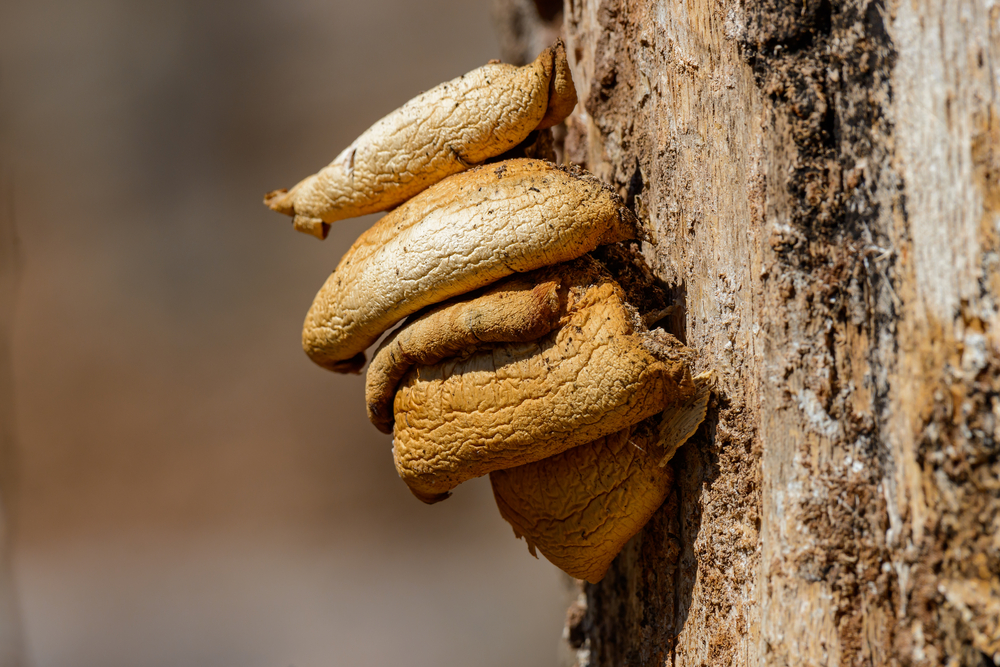
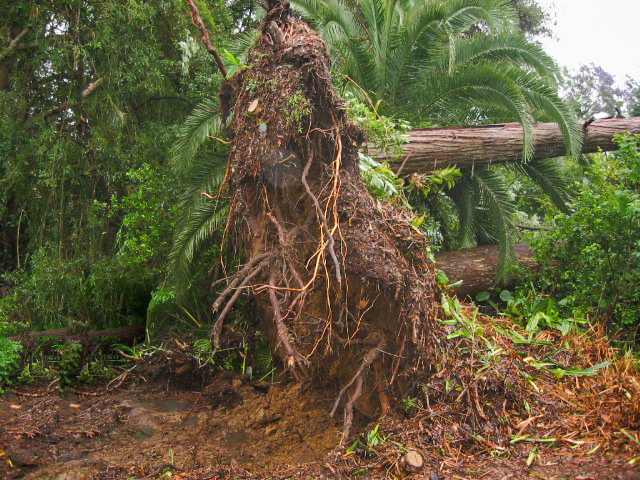
Accessing the tree
- if a tree is not to be felled from the ground, conduct a site specific risk assessment to help you decide the safest way of accessing the tree which may include the use of an EWP, a crane or climbing
- secure a suitable rope climbing system by using correct knots at a location on the tree which can withstand the forces of a fall
- if a crane is to be used to place a person in the tree it must be done in accordance with the plant used in connection with tree lopping – crane access method position paper
- climbing spikes can damage tree tissues which can result in infection and decay as well as creating future hazards
Competencies
- make sure that only a competent and experienced person does the risk assessment, planning, and execution of work methods and is on site to identify hazards (if necessary) to prepare an amended safe work method
- make sure all workers performing jobs with common risks are familiar with current risk control measures in place
- regularly remind workers of common controls and re-train workers as frequently as is necessary
Before tree work commences
- communicate the work method to the workers
- communicate the emergency rescue plans with everyone involved
- provide clear access routes, enforce exclusion zones and implement the traffic management plan
Managing unforeseen risks
- make sure that when any change or unforseen risk arises, eg change in wind speeds or changes to the ground condition after rain, new assessments, plans and on site management are undertaken
- new or varied plans must be as thoroughly worked through as the initial work method
Power lines
De energise the nearby power lines. If this is not possible, maintain safe distances using tiger tails where necessary. Your safe work method needs to include information on how to avoid damaging power lines or any other assets in the vicinity. Electricity network operators also provide useful information.
A spotter should be available to alert the operator to hazards using a communications system understood by everyone involved.
Climbing
- secure a suitable rope climbing system by using correct knots at a location on the tree which can withstand the forces of a fall
- wear climbing spikes that are maintained as per manufacturer’s recommendations
- climbing spikes can damage tree tissues which can result in infection and decay and can create future hazards
- always maintain two points of attachments to the tree, particularly while cutting or moving on a dead tree eg use a flip line and a climbing rope
Plant and equipment
- use plant and equipment only within its capabilities and in accordance with manufacturer’s recommendations
- do not use mobile plant:
- on soft ground
- where underground assets are present
- on recently filled excavations
- sloping or uneven surfaces
- if not design for such purposes
- ropes should not be attached to the plant or equipment
- plant needs to be inspected and maintained as per the manufacturer’s recommendations
- the top of the EWP basket should be located at the same level or above where the cut is made
- workers in the EWP basket need to wear full body harness, to prevent being flicked out in the event the boom springs back, eg if the basket snags
- do not carry fuel in the basket of the EWP
Chain saws
- never drop start a chain saw when working on the ground
- wear cut resistant leg protection, hearing and eye protection when using a chainsaw
- start and warm up the chainsaw before climbing to prevent starting difficulty while the climber is on the tree
Working in the sun
To reduce the risk of heat related illness and fatigue, be proactive and develop plans. Make sure workers are protected when working outdoors by monitoring the weather forecasts, planning ahead and rescheduling certain tasks to earlier or later in the day.
Australian workers are more vulnerable to skin cancer due to exposure to high levels of UV radiation. Workers are encouraged to take precautions to avoid sun damage. It is advisable to wear comfortable task specific clothing, a hat, SPF 30+ sunscreen, lip balm and wraparound sunglasses.
When working in hot environments it’s better to have frequent smaller drinks of cooled water rather than infrequent large drinks. On hot days it is preferable to drink a small cup (200ml) of cool water every 15 to 20 minutes.
Watch the video safety alert below for tips on working safely with trees.
More information
SafeWork Australia has a guide to managing risks of tree trimming and removal work and an information sheet on tree and vegetation management near overhead electric lines.
We have developed a Woodchipper guide to assist in the control or elimination of certain risks associated with the operation of a trailer-mounted handfed wood-chipper.
Use our checklist to conduct a self-assessment of your workplace to determine if you have safe work practices in place.
The code of practice for the amenity tree industry provides practical guidance on safety requirements for the industry and the code of practice for work near overhead power lines will assist in managing electrical risks associated with work near overhead power lines.
Section 221 of the Work Health and Safety Regulation 2025 has information for plant used in connection with tree work.
Hazardous noise can destroy the ability to hear clearly, use code of practice for managing noise and preventing hearing loss at work for practical guidance on how to control health and safety risks arising from hazardous noise.
People who engage tree work contractors should use our checklist to ensure they hire a professional who is insured and can advise how they do the job safely.
SafeWork NSW would like to acknowledge Arboriculture Australia and Tree Contractors Association Australia for their contribution.
